The efficiency of district/community heating schemes can depend heavily on the design of the heat interface units in the system. Silas Flytkjaer highlights the key challenges and how they can be addressed
In last month's HVR there was an article explaining the benefits of modulating, modular combined heat and power (CHP) units serving district heating systems. However, as well as using the right CHP plant and controlling it effectively, it is equally important to address the efficiency with which the heated water is used within the system.
For example, where CHP is serving a number of discrete spaces, such as apartments, it is now common practice to install a heat interface unit (HIU) within each space. The HIU then controls the space heating and domestic hot water (DHW) in that space.
Historically, though, HIUs have been treated as accessories rather than a key element within the system. And the results have frequently been disappointing for the end user - and embarrassing for the specifier. This can be avoided by fully understanding the role of the HIU, its potential benefits and the design of HIU that will enable maximum efficiency.
Lack of controlA case in point is the lack of control functionality in standard HIUs, resulting in an unresponsive system with poor temperature control of DHW. The answer lies in ensuring precise control of space heating and DHW through use of appropriate valves.
In this way the heating circuit can be designed for direct distribution of heat through the HIU, or indirect distribution of heat through an extra heat exchanger to provide hydraulic separation of the primary and secondary circuits. A differential pressure controller is used to prevent excess differential pressure across the combined heating circuit.
This helps to optimise conditions for thermostatic radiator valves, ensuring low return temperatures and accurate balancing of the heating circuit (as recommended by CIBSE Commissioning Code W and Part L of the Building Regulations). A zone valve with actuator can also be included to allow timedependent temperature control.
The DHW is heated via a heat exchanger and the temperature is regulated with a flow-compensated temperature controller with integrated differential pressure controller. Heat is transferred from the flow water to the DHW via a heat exchanger, ensuring that DHW is delivered at a safe temperature, while the control valve compensates for variable loads, supply temperatures and differential pressures.
This protects the heat exchanger against overheating and lime scale formation. It also avoids the need for separate DHW storage in the apartment.
Another potential problem with district heating HIUs is a long delay in the supply of sufficiently hot DHW, especially when space heating demands are low. Temperature may also be affected by DHW usage in other parts of the building.
A well-designed HIU will incorporate an idle temperature controller in the control valve to ensure water in the supply pipe remains warm. This means the DHW is responsive at all times. In parallel, it's important to include thermostatic control of DHW temperature at varying inlet pressures so it is not affected by usage elsewhere in the building.
As noted earlier, high overall efficiency comes from the district heating and central plant working in harmony. To that end, low return water temperatures from the district heating will maximise the efficiency of heat sources such as CHP, biomass boilers, heat pumps or gas fired condensing boilers. In fact, for Part L compliance, it is recommended that the return water temperature from a community heating scheme should not exceed 40 deg C for hot water systems and 50 deg C for radiator systems.

SAV FlatStation HIU
To facilitate this, 'ultra low flow' balancing modules in the HIU will not only ensure temperatures are balanced in each apartment, they will also reduce flow rates in heating circuits to increase heat exchange and maximise the delta T. With this arrangement it is possible to achieve return temperatures of 15-30 deg C, greatly facilitating compliance with Part L.
It is not uncommon for DHW peak loads to be overestimated, resulting in oversized pipework and thermal stores, high return temperatures and wasted energy, as described above. This is a design issue and can be avoided by working with specialists that can advise on correct sizing.
Significant energy wastage
There can also be significant energy wastage in district heating systems through standing losses in the distribution circuits. The answer here is to make use of fully pre-insulated HIUs, including a fully insulated cover, to minimise heat losses. As well as reducing standing losses, this makes installation faster while also providing easy access for commissioning engineers.
From the client's perspective it may be important that the heat energy supplied to each apartment can be accurately measured for billing purposes. In such cases an energy meter can be integrated with each HIU and linked to an energy management service to enable either pay-as-you-go or credit-based billing.
Given the acknowledged importance of district heating systems in reducing carbon emissions we can be sure of seeing many more such schemes, often in relatively small projects using modulating CHP systems. Getting it right will depend on addressing the issues and challenges described here and selecting the most appropriate solutions.
// The author is product manager for FlatStation HIUs with SAV Systems //